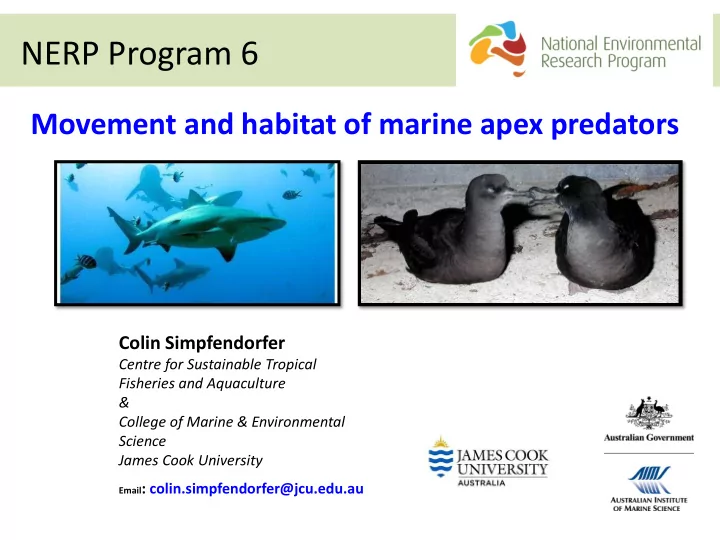

NERP Program 6 Movement and habitat of marine apex predators Colin Simpfendorfer Centre for Sustainable Tropical Fisheries and Aquaculture & College of Marine & Environmental Science James Cook University Email : colin.simpfendorfer@jcu.edu.au
Program 6 • 6.1 Maximising the benefits of mobile predators to Great Barrier Reef ecosystems: the importance of movement, habitat and Dr. Michelle Heupel environment • 6.2 Drivers of juvenile shark biodiversity and abundance in inshore ecosystems of the Great Prof. Colin Simpfendorfer Barrier Reef • 6.3 Critical seabird foraging locations and trophic relationships for the Great Barrier Reef Dr. Brad Congdon
Unifying themes • Predators are important components of marine ecosystems. • Energetic requirements mean predators may move widely. • How are predators distributed relative to marine park zoning? • How broadly do predators move within, and beyond, the GBRMP? • How effective is zoning in protecting predators?
Shark nursery areas • Issue: – 420 t TAC of sharks in GBRMP • Purpose: – Importance of coastal habitats to juvenile sharks. • Method: – Seasonal net and line surveys of 5 bays over 2 years.
Shark nursery areas ~2000 sharks captured, most tagged and released. 22 species Significant differences in shark communities between bays
Shark nursery areas Turbidity, salinity, mangrove proximity and depth were the most important environmental factors affecting catch rates of juvenile sharks.
Shark nursery areas • Conclusions – There is spatial variation in how sharks use coastal habitats along the GBR coast. – Environmental factors are key drivers of differences between bays. – Spatial variation leads to greater stability through time when conditions change. – Managing inshore waters will enhance sustainability of shark populations.
Reef shark movements • Issue: – Reef shark have been effected by fishing • Purpose – To determine the connectivity of adult reef predators • Methods – Acoustic monitoring at 17 reefs – 3 species of sharks (grey reef, silvertip and bull)
Reef shark movements
Reef shark movements
Reef shark movements
Reef shark movements
Reef shark movements Bull shark long distance movements
Reef shark movements • Conclusions – Reef associated sharks have different levels of reef fidelity, making importance in reef habitats variable. – Inter-reef movements have important implications of how we count and manage reef sharks. – Movements of all species was often greater than the size of protected GBRMP zones making additional management measures necessary.
Seabird ecology • Issue: – Seabirds depend on bait fish that can be effected by fishing and climate change • Purpose: – Map core use foraging areas of important seabirds • Methods: – Satellite tracking of short-tail shearwaters from nesting colonies
Chick provisioning resources When provisioning chicks, adults of multiple species are restricted to near-colony foraging grounds (<200km). Near-colony foraging by wedge-tailed shearwaters (2013)
Adult foraging resources On longer self-provisioning trips adults of some species routinely travel up 1000km to distant foraging grounds in the Coral and Tasman Seas. Most of these areas are outside the GBR management zone At-distance foraging by wedge- tailed shearwaters
Over-winter foraging resources When not breeding GBR shearwaters are trans-equatorial migrants that overwinter in Micronesia Non-breeding migration and overwintering areas for GBR breeding wedge-tailed shearwaters
Foraging with Tuna There is significant overlap of at- distance foraging site use with commercial fisheries, outside of GBR management boundaries
Seabird ecology • Conclusions: – Short-tail shearwater conservation is a truly international endeavour. – There is a close relationship between seabirds and tuna and this can influence conservation efforts. – Oceanography is an important driver of prey distribution. – Results will help predict the effect of climate change on seabird populations.
Conclusions • Large diversity of habitat use and movement patterns in marine predators. • Spatial scales of predator movement can present management and conservation challenges. • GBR zoning is not sufficient for conservation and management of some predators. • Additional measures and cross jurisdictional arrangements also required.
Thanks • NERP funding • Many partner organisations • The numerous staff, students and volunteers made the work possible
Recommend
More recommend